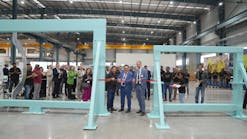Ilmor Engineering Applies Motorsport Technologies to Improve GA Aero Engine for EU Clean Sky 2 Programme
Ilmor Engineering has improved the power density of a General Aviation diesel engine by applying technologies and design solutions honed in Motorsport to successfully deliver an EU Clean Sky 2 (CS2) programme, funded by the Horizon 2020 research and innovation project aimed at reducing CO2, gas emissions and noise pollution.
Northampton, UK based Ilmor Engineering is world renowned for producing championship winning engines for Formula 1 and IndyCar and has a growing aerospace capability, which includes the development of a UAV engine and a project for Boeing that earned Ilmor a Boeing Silver Supplier Award.
The competitively awarded programme had two interdependent aims. The first and very demanding challenge was to improve power density on a certified engine by increasing power and reducing weight while also maintaining fuel efficiency. The second was to identify and apply new design techniques and technologies; the project’s remit was not to create an airworthy, certifiable power plant.
Ilmor collaborated with SMA, the Piston Engine Division of Safran Aircraft Engines, which supplied the EASA certified SR305-230E engine, a 227hp, four-cylinder, four-stroke, horizontally-opposed engine most commonly fitted to the Cessna 182. Ilmor met the initial goal to reduce mass and increase cooling performance to permit the engine to operate at a higher power output for the duration of its life. The overall mass of the engine was reduced by 2.6%, mostly by replacing the iron liners with a plasma bore coating.
The Ilmor team designed new components and redesigned existing components to meet the increased demand on the engine; and minimised the number of these components by 35%, thus improving machinability and serviceability. The team also identified a possible further mass reduction of 1.6% is available through the use of a steel piston and redesigned con-rod. Just less than 100 hours of test bench running in France proved the power increase and basic reliability, and at the same time highlighted elements that needed further refinement, many of them already predicted by the Ilmor team.
Ian Whiteside, Ilmor’s Chief Engineer – Advanced Projects, who led the CS2 programme, notes: “Increasing the power from a diesel engine is quite straightforward - you simply put more fuel in. But that generates much higher loads, so while increasing the power is easy, ensuring the engine stays together at that increased output is a challenge… and it was more of a challenge again because the requirement was to make it simultaneously lighter”.
Ilmor was able to introduce design solutions, technologies and materials used in Motorsport’s constant quest for high power output, light weight and fuel efficiency. Many are unfamiliar to the aerospace industry and the CS2 programme demonstrated they can contribute towards improving the performance and efficiency of the next generation of aero diesel engines.




